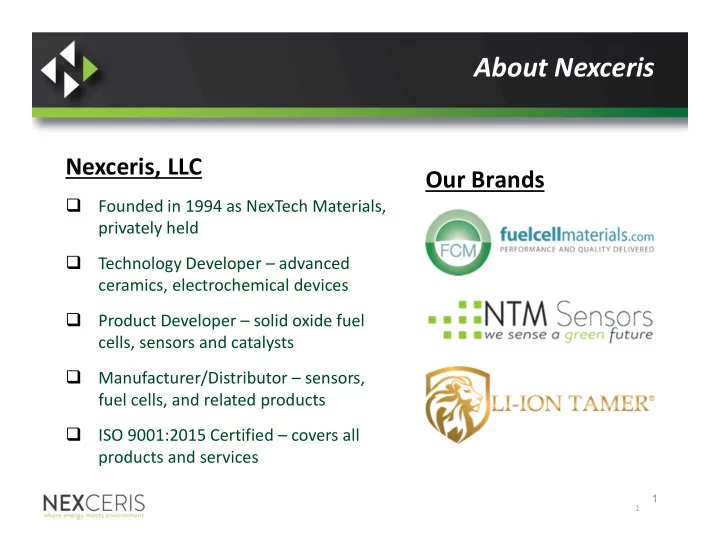

About Nexceris Nexceris, LLC Our Brands Founded in 1994 as NexTech Materials, privately held Technology Developer – advanced ceramics, electrochemical devices Product Developer – solid oxide fuel cells, sensors and catalysts Manufacturer/Distributor – sensors, fuel cells, and related products ISO 9001:2015 Certified – covers all products and services 1 SBIR Data Rights - Nexceris, LLC 1
Nexceris SOFC History Nexceris History in SOFC Technology 1994: Company founded, initiated work on SOFC materials development 2000: Established fuelcell materials division and began selling products 2004: Initiated development of planar cell designs 2006: Initiated SOFC stack development, focusing on military applications 2011: Focused efforts on SOFC materials for high performance & durability 2015: Established high power density SOFC stack design 2018: ARPA-E project on pressure tolerant, 10-kW scale SOFC stack design 2019: Initiated work on SOEC (hydrogen production) and RSOFC (energy storage) SOFC Planar SOFC Materials Cells Stacks SBIR Data Rights - Nexceris, LLC 2
Planar Cell Design Potential SOEC Advantages Relatively thin membrane for improved electrochemical performance Dense cell periphery facilitates sealing Mechanically supported membrane can withstand pressure differentials Electrodes deposited separately FlexCell (material/process flexibility) U.S. Patent No. 8,192,888 Two-layer structure with a perforated mesh layer mechanically supporting a thin electrolyte membrane SBIR Data Rights - Nexceris, LLC 3
Nexceris SOFC Stack/Hotbox Design Potential Advantages for SOEC Systems High gravimetric power density reduces materials cost and thermal mass Design integrates thermal insulation, containment and stack compression functions Electrolyte supported stack platform for ease of sealing and pressurization Open-air design simplifies egress of oxygen effluent into ambient 10-kW scale (ARPA-E) stack would be ideal module size for large-scale SOEC systems SBIR Data Rights - Nexceris, LLC 4
Recommend
More recommend